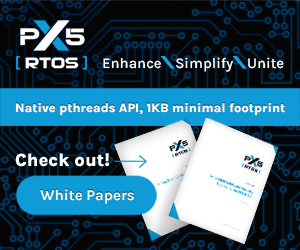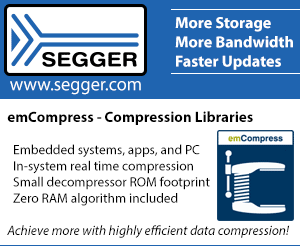
|
Volume 3, Number 1 Copyright 1998 TGG January 6, 1998
You may redistribute this newsletter for noncommercial purposes. For commercial use contact jack@ganssle.com.
EDITOR: Jack Ganssle, jack@ganssle.com
CONTENTS:
- Editor's Notes
- EC++
- Embedded Seminar in DC and San Jose
- Thought for the Week
- About The Embedded Muse
Editor's Notes
Happy New Year to all readers of The Embedded Muse! Let’s hope this is the year we get our projects out on-time and with the minimal number of bugs. Let’s also hope that as we head towards the millennium we start to learn more peaceful ways of dealing with conflict, both global and personal.
I’m doing my “The Best Ideas for Developing Better Firmware Faster” seminar in DC on January 29, and in San Jose on February 26. More info follows in this newsletter.
EC++
Long time readers of The Muse know that I’m a great fan of small systems - those 8 and 16 bit embedded systems that surround us in life.
Yet if you regularly read the trade press you’ll be hard pressed to find much written about these small systems. Believe what you read and you’ll soon come to the conclusion that even the smallest application requires a 32 bit CPU with 2 Mb of ROM and RAM.
One theme we’ve been inundated with is C++. You can hardly open a magazine without getting the feeling that C++ is the most common language around. Few articles indicate, though, that C++ is best used only on the largest systems. Forget about it for 8 bits; be very wary of using it on 16 bitters.
Though C++ does indeed bring great benefits to the art of programming, its huge footprint and performance problems limit its usefulness in a lot of embedded systems. Happily, some of the original C++ proponents are working on a subset targeted specifically at the embedded market. EC++ is a reduced version of C++ that brings many of the OOP benefits while eliminating those features that create excessive burdens for real time, embedded work.
If you’re contemplating the use of C++ for your next system, check out http://www.caravan.net/ec2plus/, which is the home page of the group developing the new standard.
Noble ideals indeed.
Several vendors either support the draft EC++ spec already, or plan to soon. These include Greenhills, Metrowerks, and Hiware.
Before redesigning your system for EC++, though, be aware that the committee designing the EC++ spec has little to no interest in 8/16 bit support. EC++, like it’s bigger brother, will be targeted primarily at 32 bit applications.
For more information on this new language, check out P. J. Plauger’s article on the subject in the December issue of Embedded Systems Programming. He gives a great overview of the differences between EC++ and C++, as well as a history and rationale behind its development.
Embedded Seminar! Washington and San Jose
I'm conducting a full-day embedded seminar in the DC area on January 29 and in San Jose on February 26. It's called "The Best Ideas for Developing Better Firmware Faster", and is for the developer who is honestly looking for new ideas, but who wants to cut through the academic fluff of formal methodologies and immediately find better ways to work.
The focus is uniquely on embedded systems. I'll talk about ways to link the hardware and software, to identify and stamp out bugs, to manage risk, and to meet impossible deadlines.
Thought for the Week
Steve Litt, Webmaster of Troubleshooters.Com (http://www.troubleshooters.com), sent along this gem in response to the Valgol language description in the last issue of The Embedded Muse:
It was gratifying to see your thorough and accurate coverage of the VALGOL language in the Embedded Muse 12. Did you know that there's now an OOP version? In much the same way that C evolved into C++, VALGOL has evolved into VALGOL TO THE MAX. It's been endorsed by the Association of Ventura Blvd Clothing Merchants, so I must use it on a daily basis (I live in Reseda). I'll show you a snippet from one of my VALGOL TO THE MAX programs (a POS system). Although this language is readable to the point of self-documentation, I'm including comments for those not familiar with VALGOL.
VALGOL TO THE MAX'S power comes from its terse readability, its powerful collection of error handling, and its self referential application pointer, called deeeude (similar to "this" in C++, but for the application only).
//*****************************************************
//This partial file copy program copies certain records //between files
//*****************************************************
like y*know (i mean) start.
FILE Tiffany = make a file.
If Tiffany isn't totally stoked
bag your face, deeeude. //abend
FILE Sean = make a file.
If Sean isn't totally stoked
bag your face, deeeude.
Sean sells at the mall //open file Sean for input
If Sean isn't just totally awesome,
later days deeeude.
Tiffany shops at the mall. //open file Tiffany for output
If Tiffany can't hang,
like, barf me out, deeeude.
//Transfer only records whose key field equals "Nirvana".
Tiffany buys all Sean's Nirvana records - oops, sorry deeeude, I mean CD's.
If any CD is bogus,
deeeude -- gag me with a spoon. //extra-fatal abend
Sean and Tiffany go home. //close the files
Reseda rules, deeeude. //exit the subroutine



